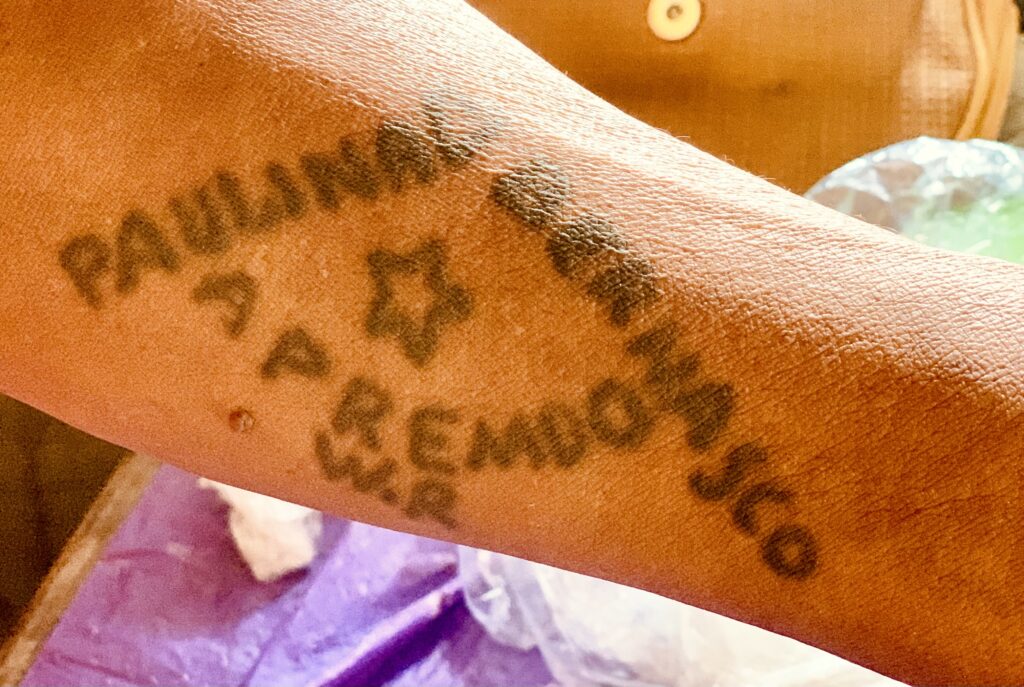
Traditional Hand Tattoo. Image Source - Ghanalingo.com
In the past, hand tattoos held a special place in Ghanaian culture, especially among the Akans. These tattoos were not just for decoration; they served an important purpose. During tough times, like the famine in 1983, many Ghanaians left their homes in search of better opportunities in places like Ivory Coast and Agege in Nigeria. To identify themselves and their roots, they used tattoos on their hands. Despite this rich history, tattooing is often overlooked today, as many see it as a modern trend rather than a traditional practice. This article explores the significance of hand tattoos in Ghanaian culture, how it was done, and how they reflect the stories of those who migrated in search of a better life.
The practice of hand tattooing among the Akans was based on tradition. Each mark told a story, showing identity, heritage, and sometimes even personal experiences. Families passed down the art of tattooing through generations, creating a strong link between the past and the present. These tattoos were not only a way to identify themselves but also a symbol of strength and perseverance.
Sadly,the significance of these traditional tattoos has faded from public memory over the past years. With the rise of modern tattoos, often viewed as art or self-expression, the traditional meanings have been overshadowed. Many young people today may not even be aware of the rich history behind hand tattoos in their culture, as they are now mostly seen on the hands of older generations.

In an exclusive interview by Ghanalingo’s Ebenezer Kobinah Offen with Kwesi Yamoah, a man from Ajumako in the Central Region of Ghana, Kwesi shared intriguing stories about the tattoos on his hands. These skin markers, often viewed as foreign in today’s world filled with wild body tattoos, hold a different meaning from the traditional tattoos once common in the Ghanaian culture.
According to Kwesi, the reasons behind the hand tattooing culture are numerous, but they all center around identification. He explained that if someone travelled and faced a calamity or passed on, the tattoo would help others recognize them and locate their families. This practice ensured that loved ones could find and support those in distress, serving as a lifeline during challenging times.
Kwesi noted that these tattoos acted as a crucial means of communication, especially in unfamiliar environments. The distinct markings on one’s hand could tell a story of origin, family, and cultural ties, making it easier for others to assist those in need. He emphasized that the tattoos served as a form of protection, ensuring that even in dire situations, there was a way to reconnect with one’s root and community.
Kwesi further indicated that during the 1983 famine in Ghana, as well as the journey to Agege in Nigeria and Abidjan in the Ivory Coast, many families who left the country bore these marks on their hands. These tattoos typically included their names, family or clan identifiers, and the names of their hometown. This practice became a vital part of their travel experience, serving as a form of identification in unfamiliar places. For those embarking on the challenging journey in search of better opportunities, these tattoos were more than just symbols; they represented a piece of home.
In moments of uncertainty, the marks on their hands provided reassurance and a connection to their roots. They also acted as a way to gain favour, especially when meeting fellow countrymen who were already doing well in their new environment. Kwesi shared stories of how these tattoos played a crucial role in helping people reunite with their families after long separations. The names etched into their skin served as a reminder of their identity, ensuring that even in a foreign land, they were never lost.
How these marks are made on the hand is also an interesting story worth sharing. According to Kwesi, he did his tattoos himself. Unlike modern tattoos that use ink, needles, and sharp objects, traditional hand tattooing was done with three small needles tied together. The process involved mixing ash from lanterns with akpeteshie to create a thick solution, which was then used to write the inscriptions on the hand. Once the inscriptions were drawn, the needles were used to pierce the skin, tracing the lines of the design. This method required precision and skill, as each mark had to be applied carefully. After the procedure, the skin would be sore, but within a week, the injury would start to heal, and the tattoos would begin to emerge.
Kwesi Yamoah’s insight reveals the meaning behind hand tattoos in the Ghanaian culture. These tattoos served as important identifiers during difficult times, helping families stay connected. The traditional methods of creating these tattoos reflect a rich cultural heritage that deserves recognition. As we remember these stories, it is crucial to appreciate the history and significance of hand tattoos in preserving identity and community among Ghanaians.
Listen to the interview via the link: https://vm.tiktok.com/ZMhmvQRLb/
Author: Ebenezer Kobinah Offen
Editor: Ama Gyesiwaa Quansah





